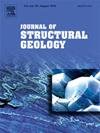Deformation and recrystallization mechanisms in glacier salt: Evolution of microstructures inferred from EBSD and microstructural analyses (Kuh-e-Namak diapir (Dashti, Iran))
IF 2.9
2区 地球科学
Q2 GEOSCIENCES, MULTIDISCIPLINARY
引用次数: 0
Abstract
This study presents a detailed microstructural analysis of salt samples collected from the exposed mountain glacier in Iran, the Kuh-e-Namak (Dashti). Our goal is to pinpoint the different deformation mechanisms leading to grain size reduction and, how these, together with the influx of rainwater and development of porosity, affect the creep of the polycrystalline halite. We investigated 17 gamma-irradiated thin sections by transmitted and reflected light microscopy, quantitative grain and subgrain statistics, and crystallographic-preferred orientation (CPO) mapping using Electron Back Scattered Diffraction (EBSD). The microstructural evidence suggests a combination of solution-precipitation accompanied by grain-boundary sliding and dynamic recrystallization. The grain size decreases by subgrain rotation recrystallization, microcracking, and grain boundary migration by three different mechanisms: 1) grain boundary bulging into grains, 2) nucleation of new grains and, 3) segmentation of porphyroclasts by planar domains of dynamic recrystallization. The mean grain size ranges from 118 to 508 μm and subgrain sizes from 14 to 99 μm from which differential stresses between 1.9 and 10.2 MPa were calculated. Inferred strain rates for the glacier are in the order of magnitude of 10−10-10−8 s−1. The increasing shape-preferred orientation of halite grains from the crestal domal part of the diapir towards the frontal parts of extrusive glaciers is interpreted as a result of dominant solution-precipitation creep and salt flow. Rainwater influx rendering this important deformation mechanism switch is attributed to the development of porosity along microcracks and grain boundaries.
冰川盐的变形和再结晶机制:从EBSD和微观结构分析推断的微观结构演化(Kuh-e-Namak diapir (Dashti, Iran))
本研究对从伊朗Kuh-e-Namak (Dashti)暴露的山地冰川中收集的盐样本进行了详细的微观结构分析。我们的目标是确定导致晶粒尺寸减小的不同变形机制,以及这些机制如何与雨水的涌入和孔隙度的发展一起影响多晶岩盐的蠕变。我们通过透射和反射光显微镜、定量晶粒和亚晶粒统计以及电子背散射衍射(EBSD)的结晶学优选取向(CPO)作图研究了17个伽玛辐照薄片。显微组织证据表明这是伴随晶界滑动和动态再结晶的溶解析出的组合。亚晶旋转再结晶、微裂纹和晶界迁移使晶粒尺寸减小,这三种机制分别是:1)晶界胀形成晶;2)新晶形核;3)动态再结晶平面区域对斑岩碎屑的切分。平均晶粒尺寸为118 ~ 508 μm,亚晶粒尺寸为14 ~ 99 μm,分别计算出1.9 ~ 10.2 MPa的应力差。推断的冰川应变率在10−10-10−8 s−1数量级。岩盐颗粒从底拔峰顶部向挤压冰川前缘的形状偏好取向增加被解释为主要的溶蚀-降水蠕变和盐流的结果。雨水涌入导致这一重要变形机制转换的原因是孔隙沿微裂纹和晶界发育。
本文章由计算机程序翻译,如有差异,请以英文原文为准。
求助全文
约1分钟内获得全文
求助全文
来源期刊

Journal of Structural Geology
地学-地球科学综合
CiteScore
6.00
自引率
19.40%
发文量
192
审稿时长
15.7 weeks
期刊介绍:
The Journal of Structural Geology publishes process-oriented investigations about structural geology using appropriate combinations of analog and digital field data, seismic reflection data, satellite-derived data, geometric analysis, kinematic analysis, laboratory experiments, computer visualizations, and analogue or numerical modelling on all scales. Contributions are encouraged to draw perspectives from rheology, rock mechanics, geophysics,metamorphism, sedimentology, petroleum geology, economic geology, geodynamics, planetary geology, tectonics and neotectonics to provide a more powerful understanding of deformation processes and systems. Given the visual nature of the discipline, supplementary materials that portray the data and analysis in 3-D or quasi 3-D manners, including the use of videos, and/or graphical abstracts can significantly strengthen the impact of contributions.
 求助内容:
求助内容: 应助结果提醒方式:
应助结果提醒方式:


